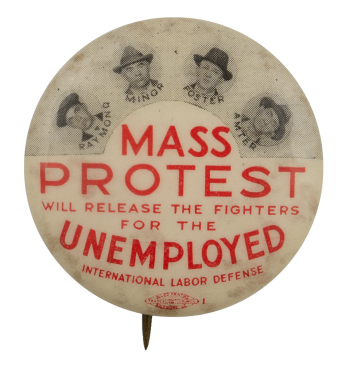| Category | |
|---|---|
| Additional Images | |
| Text on Button | RAYMOND MINOR FOSTER AMTER MASS PROTEST WILL RELEASE THE FIGHTERS FOR THE UNEMPLOYED INTERNATIONAL LABOR DEFENSE ALLIED PRINTING TRADES UNION LABEL COUNCIL |
| Image Description | White background with red text in the center. There are four sections of red text alternating large and small sizes by section. Four small circular black and white photographs of men curl around the top of the button with small black text curling around the bottom of each photograph image. |
| Back Paper / Back Info |
M. Pudl?n Co.Inc. ALLIED PRINTING |
| Back Style | |
| The Shape | |
| Year / Decade Made | |
| Additional Information | In 1930, Communist ideology was gaining popularity: membership in the Communist Party rose from 6,822 in 1930 to 66,000 in 1939. This decade shift was sandwiched between the first red scare from 1917 to 1920, and the second red scare which took place from 1947 through the 1950s. During this epoch of the Great Depression, in March of 1930, the Communist Party organized a mass unemployment protest in Union Square of New York City. Around 35,000 people attended the demonstration, which turned from peaceful to violent. The group of protestors went to City Hall to “demand a hearing from Mayor Walker.” Around 1,000 police officers used batons to break up the crowd. A number of arrests were made, including four main leaders: William Z. Foster, Israel Amter, Robert Minor, and Harry Raymond. These four individuals, along with one other man, Joseph Lester, were arrested on the charge of unlawful assembly and inciting a riot. While the men were kept in the detention pen at the police station, violence broke out, leading the four to also be charged with felonious assault. Grover Whalen served as the New York City Police Commissioner during this time. Whalen claimed “police spies” had infiltrated the Communist organization in New York City. The International Labor Defense, which was the legal defense organization for the communist party in the United States, declared they would unearth Whalen’s spy system. The defense for Foster, Amter, Minor, and Raymond claimed that Whalen’s secret police hid among the protestors and were the ones to incite a riot. On August 8, 1930, the parole board set the terms for the four arrested men. Foster, Amter, and Minor served six months, while Raymond served ten due to a past criminal history which included “grand larceny and robbery while armed.” |
| Sources |
Communist Party membership by Districts 1922-1950 - Mapping American Social Movements. Retrieved 6 April 2021, from https://depts.washington.edu/moves/CP_map-members.shtml The International Labor Defense | American Experience | PBS. Retrieved 6 April 2021, from https://www.pbs.org/wgbh/americanexperience/features/scottsboro-interna…; Protests Then: Union Square | NYC Then/Now: Great Depression & Great Recession. (2012). Retrieved 6 April 2021, from https://eportfolios.macaulay.cuny.edu/brooks12/then-protests/ Red Scare. (2010). Retrieved 6 April 2021, from https://www.history.com/topics/cold-war/red-scare Times Union. (1930). 4 'Red' Leaders Back in Jail Face Assault Charge, p. 23. Retrieved from https://newscomwc.newspapers.com/image/559591128/?terms=%22Internationa…; Times Union. (1930). Red Riot Chiefs To Be Arraigned On New Charges, p. 3. Retrieved from https://newscomwc.newspapers.com/image/558679493/?terms=%22Whalen%22%20… Times Union. (1930). Reds Start Rioting to Quit Jail Oct. 21, p. 52. Retrieved from https://newscomwc.newspapers.com/image/560364550/?terms=%22Internationa… Unemployed protests 1930s - Mapping American Social Movements. Retrieved 6 April 2021, from http://depts.washington.edu/moves/unemployed_map.shtml |
| Catalog ID | CA0835 |


